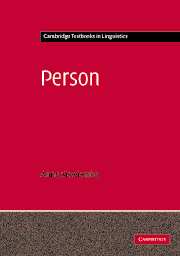Book contents
- Frontmatter
- Contents
- List of figures
- List of tables
- Preface
- List of abbreviations
- 1 Introduction
- 2 The typology of person forms
- 3 The structure of person paradigms
- 4 Person agreement
- 5 The function of person forms
- 6 Person forms and social deixis
- 7 Person forms in a diachronic perspective
- Appendix 1 List of languages in the sample by macro-area
- Appendix 2 Genetic classification of languages cited in the text
- References
- Author index
- Language index
- Subject index
2 - The typology of person forms
Published online by Cambridge University Press: 05 June 2012
- Frontmatter
- Contents
- List of figures
- List of tables
- Preface
- List of abbreviations
- 1 Introduction
- 2 The typology of person forms
- 3 The structure of person paradigms
- 4 Person agreement
- 5 The function of person forms
- 6 Person forms and social deixis
- 7 Person forms in a diachronic perspective
- Appendix 1 List of languages in the sample by macro-area
- Appendix 2 Genetic classification of languages cited in the text
- References
- Author index
- Language index
- Subject index
Summary
Given the impoverished semantics of person markers and the fact that the range of syntactic and discourse functions that they fulfil cross-linguistically must essentially be the same, the major parameter responsible for the cross-linguistic variation in person markers is morpho-phonological form. Accordingly, this chapter will be concerned with the cross-linguistic formal realization of person markers and how this relates to their syntactic and discourse function.
We will begin our discussion with a review of the existing morpho-phonological types of person markers and their cross-linguistic distribution. Then we will proceed to examine the relationships between the morpho-phonological form of person markers and their syntactic function. This will involve a consideration of, on the one hand, the formal realization of different syntactic functions and, on the other, the alignment possibilities that the different morpho-phonological types of person markers enter into and how these relate to those found with lexical expressions. The last part of the chapter will deal briefly with the existence of person markers for special discourse functions.
Morpho-phonological form
The basic division of person markers in regard to morpho-phonological form is that between independent and dependent person markers. Other terms used for the independent forms are free, full, self/standing, cardinal, focal, strong, long and disjunctive. The dependent forms are also referred to as reduced, bound, defective, deficient or conjunctive.
- Type
- Chapter
- Information
- Person , pp. 16 - 74Publisher: Cambridge University PressPrint publication year: 2004



